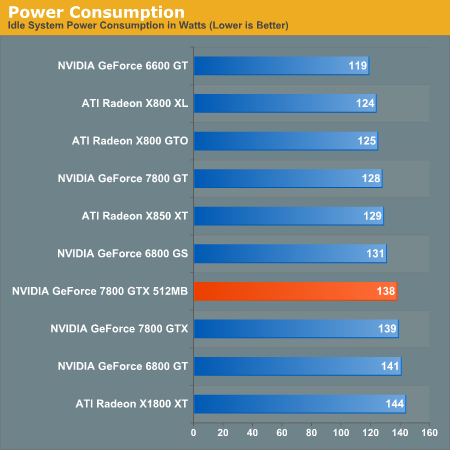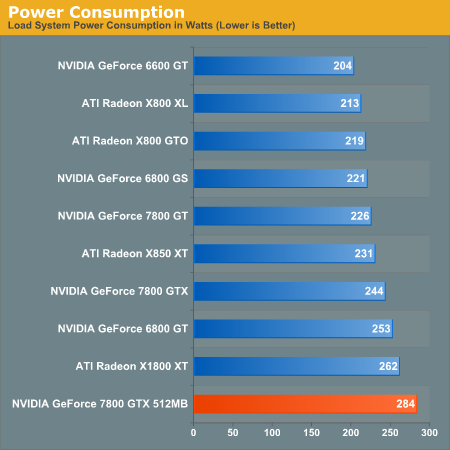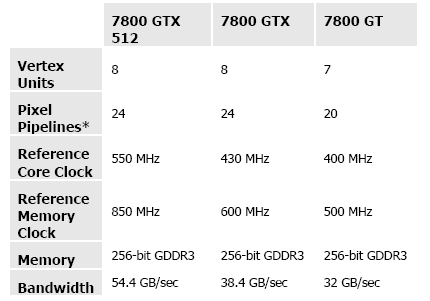NVIDIA GeForce 7800 GTX 512: More Than Just More Memory
by Derek Wilson on November 14, 2005 9:00 AM EST- Posted in
- GPUs
The Card, The Test, and Power
There are a few key changes from the original 7800 GTX silicon that allow the 7800 GTX 512 to perform so highly. The 7800 GTX 512 still uses a 110nm process like the original 7800 GTX, but NVIDIA has tuned their fab process to speed up key data paths in the chip. These enhancements, while not altering the feature set in anyway, allow the chip to reach clock speeds of 550MHz (which is 120MHz faster than the original 7800 GTX). On top of changes in the silicon, the 7800 GTX 512 has gotten a PCB revision. And just in case anyone is wondering, the huge HSF solution is actually very quiet. NVIDIA is using a fan with larger blades that move a good volume of air without needing to run at super high RPMs. While it may look like an industrial sized leaf blower, it bark is certainly nothing compared to the bite this thing takes out of our performance tests.
Current 7800 GTX cards feature 8Mx32 GDDR3 with four chips on each side of the PCB. Most cards have a heat spreader on the back of the board, while some vendors have attached heatsinks. NVIDIA needed a better way to cool their RAM in order to hit the memory clock speeds they wanted. To this end the 7800 GTX 512 sees all of its RAM on the front of the PCB cooled by the very large heatsink previously employed on the Quadro FX 4500. Moving all the RAM to one side of the PCB may also have improved the routing to certain memory modules, which would also help increase attainable stable memory clock speeds. There are still only 8 modules total, as NVIDIA has also moved to higher density 16Mx32 GDDR3. The RAM used is also rated at 900MHz (1800MHz data rate), giving the stock memory clock speed of 1700MHz a little head room for vendors who like to overclock the cards they sell.
Here is a quick comparison of NVIDIA's 7800 series line up with the new GTX 512:
Slower architectures have the advantage of being less effected by latency as a long clock cycle time allows data to move further per cycle. At the same time, to compete with high frequency processing, much more work has to get done per clock cycle than a faster chip. Graphics tend to lend themselves to this type of architecture, which is partly why we haven't seen multiple-GHz graphics chips.
In any case, increasing core and memory clocks, framebuffer size, and adding a gigantic HSF will certainly require a little more power than the standard 7800 GTX. NVIDIA currently still recommends the same types of power supplies for the 7800 GTX 512 as it does for the 7800 GTX, but, as we can see from our tests, the 7800 GTX 512 does result in a much higher power draw from the wall. In fact, the outlets in our lab had some trouble getting consistent power to our PSU during SLI testing. Most people won't run into a problem like this unless they run quite a few PCs off the same circuit breaker at home. We actually had to solve our problem by running one of the 7800 GTX 512 cards off of a second power supply plugged into an extension cord running off of a different circuit. If nothing else, this setup could help people test for wiring problems in their homes.
These power numbers are measured at the wall before the PSU.


Certainly the 7800 GTX 512 is a power hog to say the least. Unfortunately, we didn't have a reliable way to test power draw for the 7800 GTX 512 SLI setup, but if we ever get around to rewiring the lab ...
Let's take a look at the hardware we will use.
Test Hardware
This is definitely a powerful system we will be examining today. For our benchmarks, we test with sound disabled. Most of these tests are timedemos played back using ingame functionality, but the Black & White 2 benchmark is a FRAPS test using an ingame cut scene. We will provide bar graphs for the very popular 1600x1200 resolution while reporting data from 1280x960 to 2048x1536 in resolution scaling graphs.
There are a few key changes from the original 7800 GTX silicon that allow the 7800 GTX 512 to perform so highly. The 7800 GTX 512 still uses a 110nm process like the original 7800 GTX, but NVIDIA has tuned their fab process to speed up key data paths in the chip. These enhancements, while not altering the feature set in anyway, allow the chip to reach clock speeds of 550MHz (which is 120MHz faster than the original 7800 GTX). On top of changes in the silicon, the 7800 GTX 512 has gotten a PCB revision. And just in case anyone is wondering, the huge HSF solution is actually very quiet. NVIDIA is using a fan with larger blades that move a good volume of air without needing to run at super high RPMs. While it may look like an industrial sized leaf blower, it bark is certainly nothing compared to the bite this thing takes out of our performance tests.
Current 7800 GTX cards feature 8Mx32 GDDR3 with four chips on each side of the PCB. Most cards have a heat spreader on the back of the board, while some vendors have attached heatsinks. NVIDIA needed a better way to cool their RAM in order to hit the memory clock speeds they wanted. To this end the 7800 GTX 512 sees all of its RAM on the front of the PCB cooled by the very large heatsink previously employed on the Quadro FX 4500. Moving all the RAM to one side of the PCB may also have improved the routing to certain memory modules, which would also help increase attainable stable memory clock speeds. There are still only 8 modules total, as NVIDIA has also moved to higher density 16Mx32 GDDR3. The RAM used is also rated at 900MHz (1800MHz data rate), giving the stock memory clock speed of 1700MHz a little head room for vendors who like to overclock the cards they sell.
Here is a quick comparison of NVIDIA's 7800 series line up with the new GTX 512:

Slower architectures have the advantage of being less effected by latency as a long clock cycle time allows data to move further per cycle. At the same time, to compete with high frequency processing, much more work has to get done per clock cycle than a faster chip. Graphics tend to lend themselves to this type of architecture, which is partly why we haven't seen multiple-GHz graphics chips.
In any case, increasing core and memory clocks, framebuffer size, and adding a gigantic HSF will certainly require a little more power than the standard 7800 GTX. NVIDIA currently still recommends the same types of power supplies for the 7800 GTX 512 as it does for the 7800 GTX, but, as we can see from our tests, the 7800 GTX 512 does result in a much higher power draw from the wall. In fact, the outlets in our lab had some trouble getting consistent power to our PSU during SLI testing. Most people won't run into a problem like this unless they run quite a few PCs off the same circuit breaker at home. We actually had to solve our problem by running one of the 7800 GTX 512 cards off of a second power supply plugged into an extension cord running off of a different circuit. If nothing else, this setup could help people test for wiring problems in their homes.
These power numbers are measured at the wall before the PSU.


Certainly the 7800 GTX 512 is a power hog to say the least. Unfortunately, we didn't have a reliable way to test power draw for the 7800 GTX 512 SLI setup, but if we ever get around to rewiring the lab ...
Let's take a look at the hardware we will use.
Test Hardware
| CPU: | AMD Athlon 64 FX-57 (2.8GHz) |
| Motherboard: | ASUS A8N32-SLI Deluxe |
| Chipset: | NVIDIA nForce4 SLI X16 |
| Chipset Drivers: | nForce4 6.82 |
| Memory: | OCZ PC3500 DDR 2-2-2-7 |
| Video Card: | ATI Radeon X800 XL ATI Radeon X1800 XT ATI Radeon X850 XT NVIDIA GeForce 6800 GS NVIDIA GeForce 7800 GT NVIDIA GeForce 7800 GTX NVIDIA GeForce 7800 GTX 512 |
| Video Drivers: | ATI Catalyst 5.11 (WHQL) NVIDIA ForceWare 81.89 (Beta) |
| Desktop Resolution: | 1280x960 - 32-bit @ 60Hz |
| OS: | Windows XP Professional SP2 |
| Power Supply: | OCZ PowerStream 600W PSU |
This is definitely a powerful system we will be examining today. For our benchmarks, we test with sound disabled. Most of these tests are timedemos played back using ingame functionality, but the Black & White 2 benchmark is a FRAPS test using an ingame cut scene. We will provide bar graphs for the very popular 1600x1200 resolution while reporting data from 1280x960 to 2048x1536 in resolution scaling graphs.










97 Comments
View All Comments
stephenbrooks - Monday, November 14, 2005 - link
Shh don't say that or they'll deliberately start making games with detail that can only be seen at 1600x1200 to drive hardware sales... :)ElFenix - Monday, November 14, 2005 - link
by testing power consumption with and without SLI/crossfire you can figure out the consumption of a single card with pretty decent accuracy.Leper Messiah - Tuesday, November 15, 2005 - link
um, if you read the review, they said that they had to run two different circuts in their testing room due to the power draw, on two different PSUs. I guess that you could put two measuring devices up, but IDK how accurate that's going to be...Nice card BTW. Makes my 9800pro look like Intel's intergrated graphics...
ElFenix - Tuesday, November 15, 2005 - link
yeah, i saw that part. but they don't have to do it on just the SLI'd 512. in fact, they could do it with any card, subtract out two cards worth of power to find out the base consumption of the system, and then subtract from the 512 to get just the 512's consumption.it's just a thought.
PrinceGaz - Tuesday, November 15, 2005 - link
Sounds to me like the AT lab in question really needs to be looked over by an electrician if the mains circuit can't supply enough power to run a few computers. Here in the UK, even domestic households should have 13 amp sockets (which with our 230V mains voltage is equivalent to 3KW power), and a typical ring main circuit will be rated for some 30amps (or 7KW). You can run a helluva lot of computers with up to 7KW of juice available on each ring, and this is just an average home. Of course the electric bill will be a bit scary if you do use that much :)I know things aren't so good in the US as you are only on 110V mains-supply so either the wires need to be a lot thicker to carry the higher current (nearly 30 amps for 3KW, and over 60 amps for 7KW), but still you shouldn't have a problem drawing say 2KW or so. Or is it normal for US mains wiring to be rubbish?
bob661 - Tuesday, November 15, 2005 - link
Old homes usually have crappy wiring over here. I ran about 15 computers off of a 15 A breaker before tripped at a LAN party.bob661 - Tuesday, November 15, 2005 - link
I wish for an edit button. That said, I ran those 15 computers in a new house (newer than 5 years).Live - Monday, November 14, 2005 - link
Nice review! Still have a question tough:Considering this cooler uses heat pipes how does the orientation of the card affect performance? It looks to me that if positioned with the cooler on the downside as in a normal ATX tower the heat is traveling downwards instead of up as it should. This should in theory affect performance negatively. Granted the angel and distance is not that great but it would be nice to know.
The reason I ask it that many of the test done on review sites are done on an open test bed with desktop style orientation of the motherboard. How AnandTech test I don’t know but if orientation affect cooling the reviews seen today might be off in temperatures, sound and I guess overclocking.
Other comments:
As always on AT I miss minimum fps and/or some time scale to see how much of the time the card drops under say 30 fps or whatever is “unplayable” in different titles.
CPU scaling would be nice to but I guess that is for another article.
I also really think you should consider building up some testing methodology for sound. It does not have to be exact. Just use quiet watercooling like the reserator from Zalman and passive PSU and sound proof the test area a bit and buy a good soundmeter and you should be set to go. Considering the budget of AT and the considerable benefit for the readers I can’t se how that would be a high cost. Noise matters!
AtaStrumf - Monday, November 14, 2005 - link
Just thought I'd drop by and tell you all that Black & White 2 runs just fine on R9600XT/A643000+(S754) machine at 1280*1024, so it's not as demanding as you made it out to be, if you only turn off some GPU raping quality settings. Thumbs up to Lionhead for that.Nice card nVidia! Now that you've crushed ATi AGAiN, how 'bout you get to work on the 7600GT eh???
Yea ATi have become the Intel of GPUs (high clocks, not so good performance, failed launches), and nVidia looks even better than AMD (relatively low clocks, high performance, great launches). But let's not forget ATi has the XBOX360 just around the corner and nVidia still has some time to play till PS3 comes out, so I'd guess they had more spare time on their hands or something.
As for my pseudo X850 XT looking like a dog in this graphs, let's not forget we're talking 1600x1200 @ HIGHEST QUALITY!!! here. It's still a fine card for the money (born from X800GTO2 ;-) though CoD2 is a real performance hog and I don't really know why. Probably some stupid quality setting, we'd be better off without.
2005 was nVidia's year but I'm willing to bet in 2006 we'll see ATi coming back strong. R580 should be the breakthrough I think.
Deku - Wednesday, January 4, 2006 - link
"Just thought I'd drop by and tell you all that Black & White 2 runs just fine on R9600XT/A643000+(S754) machine"I've got Black and White 2, and a Radeon 9550 and it works generally fine...problem is, I can't change detail levels of features such as vegetation or water detail to at least a decent state...it's unavailable to me, and I've sent an email to Lionhead and they haven't replied yet...do you need some high-end card to get it to work or something? Lionhead obviously didn't realize that not everyone in the world's going to buy a new computer everyday...which really does annoy me.